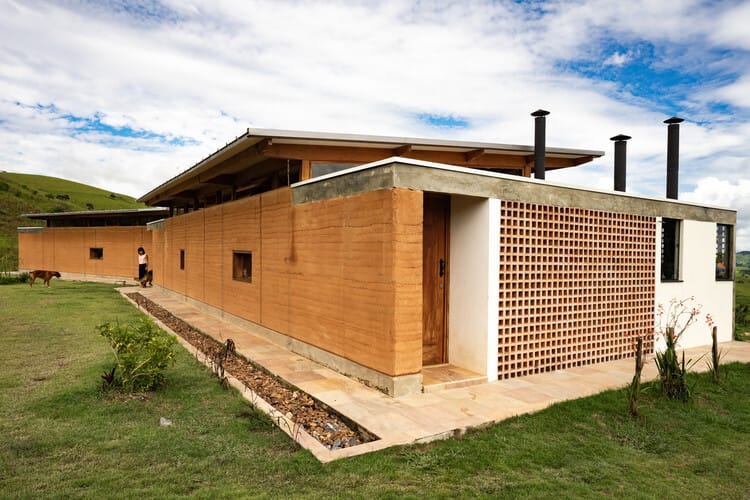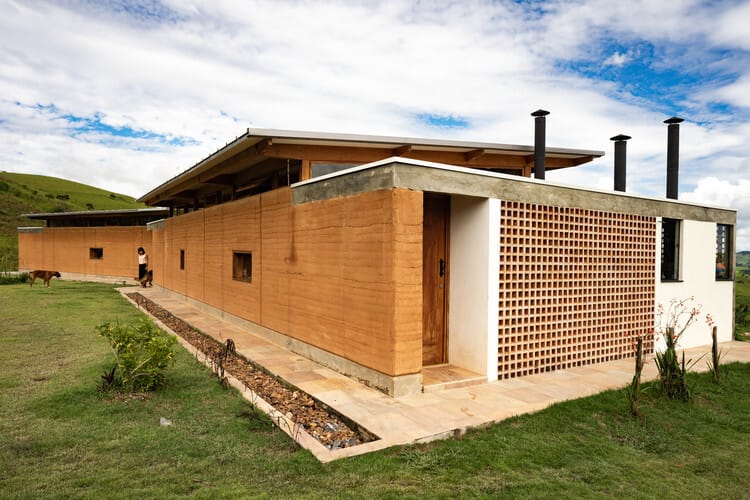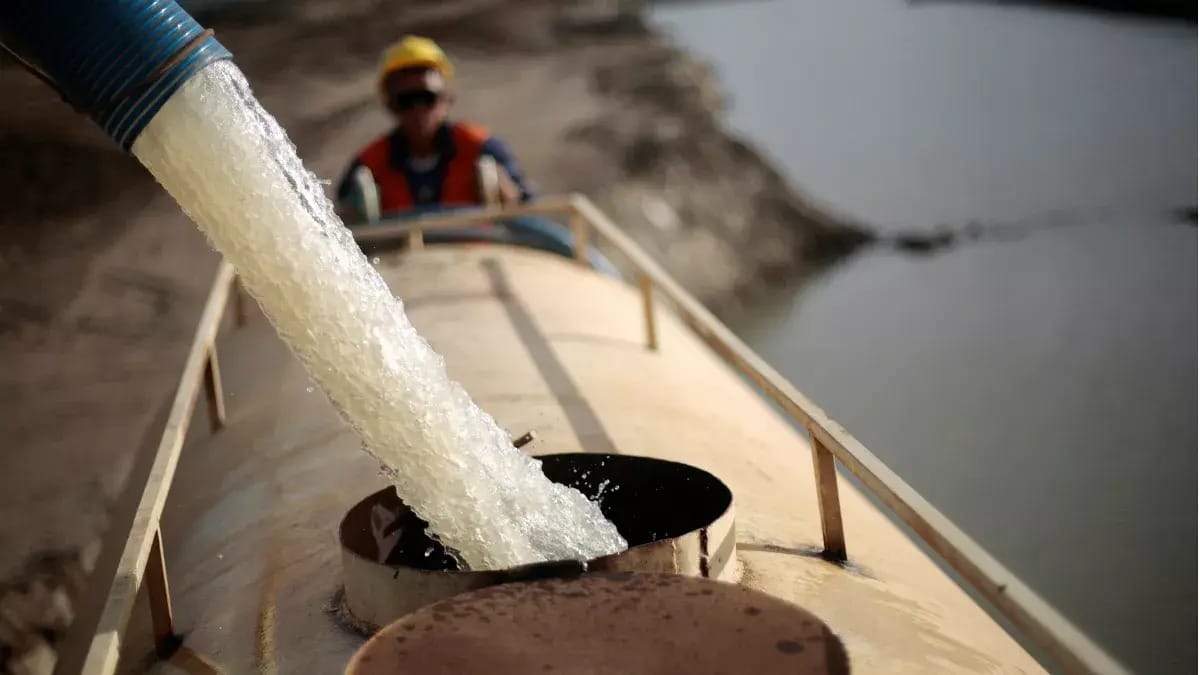- UGREEN
- Posts
- House Made of Earth, UGREEN Mentorship, Water as the New Oil.
House Made of Earth, UGREEN Mentorship, Water as the New Oil.
Your UGREEN News is live!

News
What Earth Really Teaches Us About Sustainability

Credits: ArchDaily Brasil
Have you ever heard someone say that earthen houses don’t last? That they’re old-fashioned, fragile, that they melt away in the rain? Well … this is one of the biggest myths still haunting natural building.
The truth is quite the opposite. Earthen constructions can be extremely durable — and history proves it. Parts of the Great Wall of China, the houses of Ouro Preto in Brazil, and raw-earth buildings in Yemen have stood for centuries. All built with techniques that, when well applied, endure across generations.
The real question isn’t whether earth lasts. The question is: how you design and care for it.
Durability Comes from Good Design
When we talk about sustainable construction, it’s easy to fall into the trap of believing that natural materials are inferior to industrial ones. But earth, when used intelligently, is no less durable than concrete or fired brick
The secret lies in combining three pillars:
Proper soil composition — the right balance of sand, clay, silt, and limited gravel.
The right building technique — whether rammed earth, adobe, or wattle and daub, each method has its own structural behavior.
Protection from water — perhaps the most critical factor. Water is a challenge, but it’s also predictable. Which means it can (and must) be planned for.
Earthen Buildings Are Smart — And Demand Smartness
The nature of earth is different. It’s strong where it needs to be, but it also requires special care.
For example, earth resists compression very well, but doesn’t like bending or twisting. This means architectural design needs to work with the material , not agains it.
A rammed earth wall, for instance, can be incredibly strong when well compacted — but you can’t treat it as if it were concrete. It’s not. That’s why it’s so important to respect its limits and take advantage of its unique qualities, such as thermal mass, low environmental impact, and full recyclability.
Water Is a Predictable Enemy
Have you heard the golden rule of natural buildings?
“Design the feet and the hat of the house.”
This simple phrase sums up centuries of wisdom.
The feet: moisture rising from the ground through capillarity can damage a wall. The solution? Elevate the foundation, use stone or brick at the base, ensure good site drainage.
The hat: wide rood overhangs and drip edges keep rainwater of the walls. It sounds simple, and it is — but it makes all the difference.
The skin: a natural plaster, like clay or lime, acts as a sacrificial layer. It protects, absorbs, and can be renewed periodically. Today, it can even be combined with modern water repellents if needed.
But How to Stabilize?
Adding lime or cement to the soil increase strength and durability. But it comes with an environmental cost. The challenge is balance: using the minimum necessary, and only when strategically justified.
Natural building isn’t about doing everything “the old way”. It’s about using today’s knowledge and technology to enhance what was already good — without losing the commitment to the planet.
And What About Pests?
It’s true: when we use natural fibers (like straw) or wood, we can attract insects.
But that also has solutions:
Sealing cracks and gaps,
Using natural treatments, such as diatomaceous earth,
Applying specific chemical barriers in more severe cases.
Pests are not unique to earthen houses. What changes is the type of care required.
A Quick Comparison
It makes no sense to compare earth with concrete without considering environmental, thermal, and maintenance contexts. Here’s a simplified comparison:
Material | Lifespan (with maintenance) | Environmental Impact | Thermal Comfort | Recyclability |
|---|---|---|---|---|
Earth | High | Very Low | Excellent | Total |
Concrete | High | High (CO2) | Good | Low |
Fired Brick | High | High (kiln firing) | Medium | Moderate |
Earth, in addition to lasting, returns to being earth at the end of its useful life. That’s circular economy in action.
Building with Earth Is an Act of Resilience
Reviving earthen construction is more than just a technical choice. It is an act of reconnection — with the planet, with time, and with a way of living that respects cycles, limits, and possibilities.
With the right knowledge, earth can (and should) be used as a foundation for a more sustainable future —without giving up durability.
UGREEN Mentorship
The New Transformation of Architecture Has Already Begun. Will you Lead — or Fall Behind?

In an increasingly saturated market, doing “more of the same” is no longe an option.
Architecture that merely complies with regulations does not stand out. Superficial sustainability does not transform.
Today, the leaders are the professionals creating real solutions for climate, social, and urban challenges — and that opportunity is within your reach!
The UGREEN Sustainable Architecture Mentorship 2.0 is an intensive program of 4 live sessions, designed for those who want to:
Move beyond theory and apply sustainability strategically in their projects;
Learn the world’s most advanced methodologies (such as those applied in the Middle East, in cities like Masdar City and The Line);
Integrate biophilia, biomimicry, social impact, and resilience into proposals with high added value;
Achieve differentiation and authority in the sustainable architecture and urbanism market.
For Those Who Want to Transform (and Be Transformed)
Mastering the tools and perspectives shaping the neighborhoods of the future will help you design spaces that regenerate, that embrace, and that become a living part of the urban ecosystem.
Our mentorship goes far beyond technical content:
It is a training with immediate application, connection to a global community of changemakers, and the momentum your career may need to take its next leap!
And it all begins next Tuesday (October 7).
Get Ready to Take the Next Step
If you want to position yourself as a professional prepared for the challenges (and opportunities) of today, this is your moment!
Opinion
Water as the New Oil? The Strategic Resource of the 21st Century

Credits: Euronews.com
If the geopolitics of the last century revolved around oil, today the world’s eyes are increasingly turning toward an even more essential resource: water.
Reports released by the United Nations (UN) in 2023 indicated that more than 2 billion people worldwide still live without safe access to drinking water. Meanwhile, extreme climate events — from floods in Europe to prolonged droughts in the Global South — reinforce a warning that can no longer be ignored: water is becoming the political, economic, and environmental centerpiece of the 21st century.
A Global Crisis with Local Impacts
According to a study by UNESCO and the World Water Assessment Programme (2023), global demand for freshwater is expected to increase by 55% by 2050, putting further pressure on already overburdened urban and rural systems.
At the same time, in 2023 the World Health Organization (WHO) estimated that 1.4 million deaths per year are caused by diseases that could be prevented with adequate access to safe drinking water and basic sanitation.
Did you know? The city of São Paulo faced a severe water crisis in 2014, while Cape Town, South Africa, came close to the so-called “Day Zero” in 2018 — when reservoirs nearly dried up completely. These cities are just two examples of a reality that could reach hundreds more around the world.
Climate, Water, and Disasters: The New Normal?
According to the report State of the Global Climate 2024, published by the World Meteorological Organization (WMO), the past five years have seen record droughts and floods on every continent.
In Europe, the worst floods in over a decade left 335 dead and caused more than €18 billion in damages (WMO, 2024). In Brazil, the disaster in Rio Grande do Sul between April and May 2024 affected 2.3 million people, with damages exceeding R$87 billion, according to Civil Defense and the National Institute of Meteorology.
These events are not isolated — they reflect the growing volatility of the water cycle, driven by climate change and uncontrolled urbanization.
The Geopolitics of Water: Cooperation or Conflict?
A study by the University of Utrecht, Netherlands, revealed that 40% of the world’s population depends on rivers and aquifers that cross national borders (Utrecht Institute for Water, 2022). This raises a critical question: will water be a factor of unity — or of dispute?
Landmark Cases:
In Northeast Africa, the Grand Ethiopian Renaissance Dam on the Nile River triggered diplomatic tension with Egypt, which depends on the river for over 90% of its water supply (BBC News, 2023).
In South Asia, the long-standing dispute between India and Pakistan over the Indus River remains one of the oldest in the world. According to the International Crisis Group (2020), while the Indus Waters Treaty, mediated by the World Bank in 1960, has survived decades of tensions and even wars, India’s recent dam projects have sparked concerns in Pakistan about reduced water flows. The treaty allows India limited use of the waters for irrigation and hydropower, but any perceived violation is treated as a national security threat in Pakistan.
When Water Becomes a Commodity
In 2020, water officially entered the financial market, with futures contracts traded on the New York Stock Exchange under the Nasdaq Veles California Water Index (NQH2O). The idea? To allow major consumers to hedge against price volatility — just as they do with oil or gold (Bloomberg, 2021).
But pricing water brings an ethical dilemma.
On one hand, it encourages efficient use and investment in infrastructure. On the other, it raises the risk of commodifying a human right, recognized by the UN since 2010.
Inspiring Solutions: From Theory to Practice
The good news: solutions exist — and they are being implemented in different parts of the world.
Sponge Cities (China)
Created by architect Kongjian Yu, these cities use green infrastructure (green roofs, permeable pavements, artificial lakes) to absorb and purify rainwater, reducing floods and promoting urban biodiversity. More than 70 Chinese cities have already adopted the model (Nature-Based Solutions Journal, 2023).
Water Reuse (Brazil)
Researchers at UFPE (Federal University of Pernambuco) developed DesviUFPE, a low-cost device for reusing greywater and rainwater in low-income housing. The project reduces costs and increases water resilience in vulnerable communities (UFPE, 2023).
Sustainable Desalination (Middle East & Caribbean)
In Saudi Arabia and the Bahamas, new plants use solar energy to desalinate seawater, avoiding fossil fuel dependence. In addition, startups in Israel are using biotechnology to treat residual brine, turning waste into industrial inputs (World Bank Water Innovation Lab, 2023)
Global Governance: Water as a Planetary Public Good
Water knows no borders. That’s why initiatives such as the Water Resilience Coalition, linked to the UN Global Compact, are gaining traction among business leaders. Companies like Nestlé, Unilever, and Microsoft have pledged to achieve water net-positive operations by 2050 (UN Global Compact, 2023).
Meanwhile, the World Bank launched in 2024 the strategy “Water for People, Water for Food, Water for the Planet”, promoting financing for resilient infrastructure, access to sanitation, and smart water management technologies (World Bank Water Strategy, 2024)
Conclusion
Water is not just a resource — it is a symbol of our times.
It can unite or divide. Save or destroy. Create wealth or deepen inequality.
But above all, it represents a choice: will we treat it as a commodity, or as humanity’s shared inheritance?
Reply